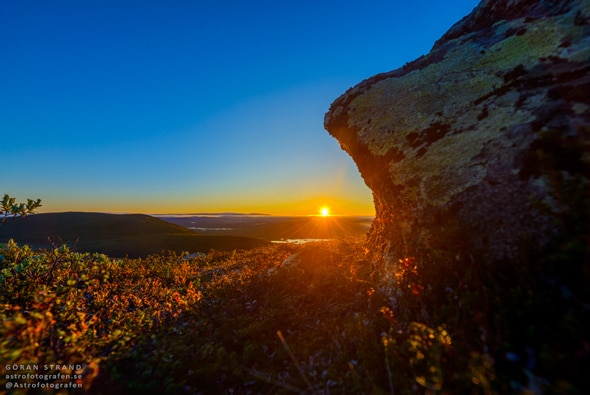On the Ball of the Midnight Sun

Imagine you are on a large sphere.
Got it? Now imagine that sphere is spinning. As it does, two poles are defined: You can call them what you like, but “top” and “bottom” work. Halfway around the sphere from the top one toward the bottom is the sphere’s midsection. You can call it what you like, but “waist” works.
Now imagine there’s a source of light some distance off. Imagine too this source of light is carefully placed such that the axis of rotation of the sphere is perpendicular to the direction to the light. In other words, the sphere spins vertically. The light then illuminates half the sphere, but as the sphere spins every point on its surface will eventually get lit during one rotation.
If you stand on a pole, let’s say the top one, you spin in place, once per sphere rotation. To you, the source of illumination spins around the sky, neither rising nor setting. It just goes around. The same is true if you’re on the bottom pole, too.
If you’re on the waist, in one spin you make a big circle, the size of the circumference of the sphere. For half a spin the source of illumination is visible, but for the other half it’s behind the sphere and you can’t see it. The light rises, goes directly overhead, and sets again after half a rotation, then rises again a half rotation later. If you’re anywhere else on the sphere except a pole (and if the sphere is very large compared to you), the Sun will rise and set but won’t go overhead.
But now let’s tilt the sphere. It can go any way, but let’s say the top pole it tipped toward the light. If you stand on the waist, the light still rises and sets, but instead of going overhead it makes a lower arc in the sky, never quite reaching the overhead point. How much it misses depends on how much the sphere is tilted.
If you stand on the bottom pole, tipped away from the light, you’re still spinning in place, but you’re facing away from the light. The light is always blocked by the sphere, so you never see it. It’s always dark.
If you stand on the top pole, you’re still spinning in place, but now the light appears to go up and down over one spin. It doesn’t get blocked by the sphere, but it does get low, close to where the sphere blocks the sky (let’s call that the “horizon”). If you move away from the pole, down toward the waist by just the right amount, then the light will just kiss the horizon as it dips down before moving back up again. The distance you have to be from the pole for it to do this depends on the amount the sphere is tipped.
Now. If you’re on the top pole, what would that look like?
That wonderful time-lapse video was taken by astrophotographer Göran Strand just a little more than a day ago. He was standing on a big sphere—the Earth. The Earth is tilted, by about 24°. It goes around the light source (the Sun), but the tilt stays the same, so at one point in that journey the top (north) pole is tipped as much toward the Sun as it can be. We call that point in its orbit the solstice.
Strand was just the right distance from the North Pole, so that the path the Sun made in one rotation (one day) just barely stays above the point where the Earth blocks the sky (the horizon). He saw it make a big circle in the sky, taking one spin (one day) to go around.
Someone much farther away from the pole saw the Sun rise and set over the course of that day, but not Strand. Whereas it was the middle of the night for that person farther away, Strand never saw the Sun leave the sky.
And that’s why this phenomenon is called “the Midnight Sun.” Strand took that photo from just inside the Arctic Circle (24° south of the north pole), in Gällivare, Sweden, at just about midnight local time. Gällivare is at a latitude of 67°N, or 90 – 67 = 23° from the pole. Anyone there or closer to the pole never saw the Sun set that day.
And anyone inside the Antarctic Circle, 24° away from the south pole, never saw the Sun rise that day. It’s always night there right now, and if you’re on the pole you won’t see the Sun rise until September.*
Think of it! You are on a tilted sphere that is madly spinning as it whirls through space around a distant light source, creating day and night and seasons and climate and weather, which over billions of years has impacted geology and sculpted life to adapt to the day/night cycle, the annual cycle, the change in light versus distance from the poles. We set our calendars to these cycles, our clocks, our very lives to these cycles caused by our rotating, oblique planet.
Don’t think science affects your life? Think again. It affects everything.
* Right now, two members of an NSF team there are very ill, and a rescue mission has been mounted to bring them back north for medical attention. It is always dark there, and very, very cold, so this is nothing short of a heroic effort. The plane landed there on Tuesday and has begun the arduous journey back.


























